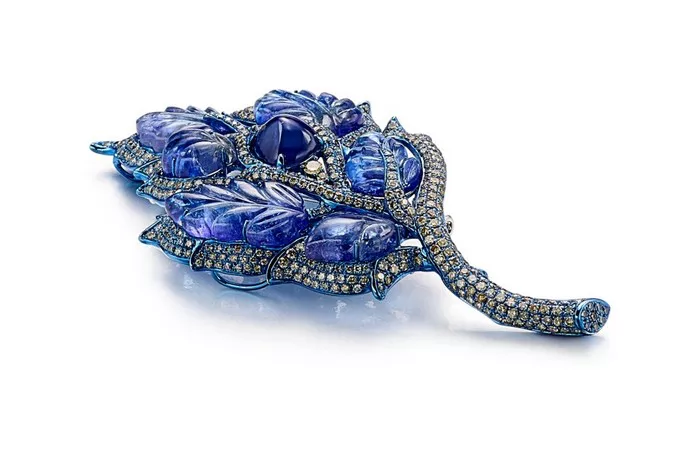Tanzanite, a stunning blue-violet gemstone found only in the Mererani Hills of Tanzania, has captivated the hearts of gem enthusiasts and jewelers worldwide. Its unique coloration and rarity have made it a sought-after treasure, often compared to sapphires for its deep, vibrant hues. However, one of the most debated topics among collectors and gemologists is whether lighter or darker tanzanite holds more value. In this article, we’ll explore the characteristics of tanzanite, delve into the factors influencing its price, and ultimately determine which variant tends to be more expensive.
The Allure of Tanzanite
Discovered in 1967 by a Maasai tribesman and brought to the gemstone market by Tiffany & Co., tanzanite quickly became a favorite due to its remarkable trichroism, displaying three different colors depending on the angle of view: blue, violet, and burgundy. This optical phenomenon, coupled with its rarity, has secured tanzanite’s position as one of the most beloved gemstones.
Understanding Tanzanite Color Grading
Tanzanite’s color can range from light blue to deep violet-blue. The Gemological Institute of America (GIA) grades tanzanite color based on hue, tone, and saturation:
Hue: The basic color of the gem (blue, violet, or a mix).
Tone: The lightness to darkness of the color.
Saturation: The intensity or purity of the color.
Factors Influencing Tanzanite’s Price
Several factors contribute to the valuation of tanzanite, including color, clarity, carat weight, and cut. Let’s break down each factor:
1. Color
The color of tanzanite is the most significant factor in determining its value. Generally, the deeper and more vivid the color, the higher the price. This principle is based on market demand and aesthetic appeal. Darker tanzanite, with its rich blue-violet hues, is typically more prized and thus more expensive. However, there are exceptions and nuances to this rule, as we will explore.
2. Clarity
Clarity refers to the presence of inclusions or imperfections within the gemstone. High-clarity tanzanite, free from visible inclusions, commands a higher price. Inclusions can disrupt the gem’s overall appearance and reduce its value.
3. Carat Weight
Like most gemstones, the value of tanzanite increases with its size. Larger stones are rarer and thus more valuable. However, the impact of carat weight on price is also influenced by the quality of color and clarity.
4. Cut
The cut of tanzanite affects its brilliance and overall visual appeal. A well-cut tanzanite will display its trichroic nature beautifully, enhancing its color and increasing its value.
Lighter Tanzanite: Characteristics and Market Perception
Lighter tanzanite, ranging from pale lavender to sky blue, often exhibits a softer, more subtle beauty compared to its darker counterparts. These stones are typically found at shallower depths and may require less heat treatment to enhance their color.
Advantages of Lighter Tanzanite
Unique Appeal: Lighter tanzanite can offer a unique, delicate charm that stands out in the market. Some collectors and designers prefer these hues for their understated elegance.
Affordability: Generally, lighter tanzanite is more affordable than darker varieties, making it accessible to a broader range of buyers.
Versatility: The lighter shades can be more versatile in jewelry design, complementing a variety of settings and styles.
Market Perception
While lighter tanzanite may not command the highest prices, it holds a distinct place in the market. Its appeal lies in its rarity and the subtle beauty that attracts those looking for something different from the more intense, darker stones.
Darker Tanzanite: Characteristics and Market Perception
Darker tanzanite, with its deep blue and violet hues, is often the most sought after and commands higher prices. These stones are typically found at greater depths and usually undergo heat treatment to achieve their rich color.
Advantages of Darker Tanzanite
Rich Color: The deep, saturated colors are highly prized and considered more luxurious.
Investment Value: Darker tanzanite often retains and appreciates in value over time, making it a preferred choice for investors.
Popularity: The market demand for darker tanzanite is consistently high, driven by its aesthetic appeal and rarity.
Market Perception
The preference for darker tanzanite is strong, with many collectors and jewelers favoring the intense hues that rival even the finest sapphires. This demand keeps prices high and makes darker tanzanite a valuable addition to any collection.
Exceptions to the Rule
While darker tanzanite generally commands higher prices, there are exceptions. Exceptional quality lighter tanzanite can sometimes fetch high prices, especially if it exhibits high clarity and a unique, pleasing hue. Moreover, personal preferences and trends can influence market values, leading to fluctuations in price.
See Also: Is Unheated Tanzanite More Valuable?
The Role of Treatment in Tanzanite Pricing
Most tanzanite undergoes heat treatment to enhance its color. This process is widely accepted and does not significantly impact the value negatively. However, untreated tanzanite, especially if it exhibits desirable color and clarity, can be rarer and more valuable.
Conclusion
In conclusion, while both lighter and darker tanzanite have their unique charms and market niches, darker tanzanite generally tends to be more expensive. This is due to its rich, saturated colors, which are highly prized by collectors and investors alike. However, exceptional quality lighter tanzanite can also command high prices, particularly if it exhibits excellent clarity and a unique, appealing hue.
The world of tanzanite is a fascinating blend of geological wonder and market dynamics. Whether you are a collector, investor, or simply a lover of beautiful gemstones, understanding the nuances of tanzanite can enhance your appreciation and guide your purchasing decisions. As with any gemstone, personal preference plays a significant role, so choose the tanzanite that speaks to you, whether it be the deep, mesmerizing blues or the delicate, enchanting lavenders.


